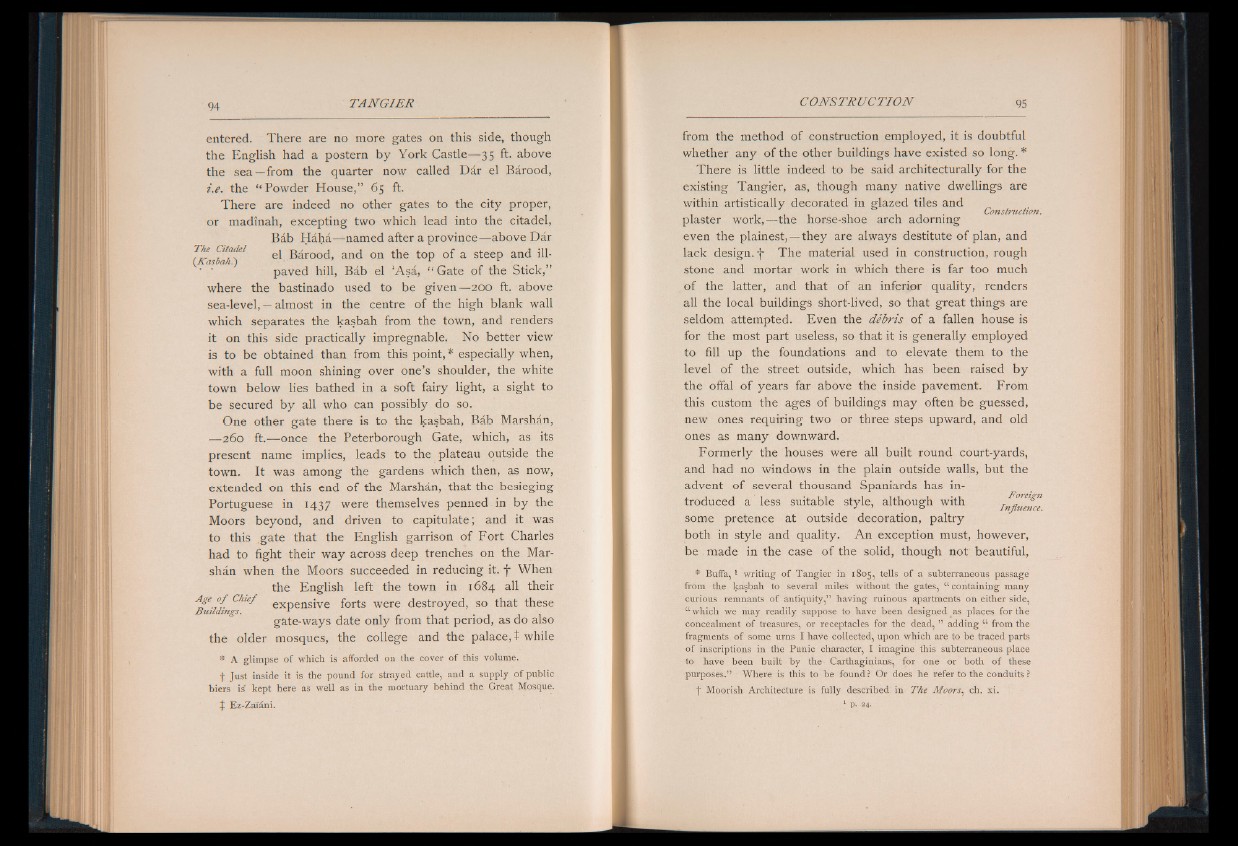
entered. There are no more gates on this side, though
the English had a postern by York Castle— 35 ft. above
the sea—from the quarter now called Dar el Barood,
i.e. the “ Powder House,” 65 ft.
There are indeed no other gates to the city proper,
or madinah, excepting two which lead into the citadel,
Bab Haha— named after a province— above Dar
% / y el Barood, and on the top o f a steep and ill-
’ ' paved hill, Bab el ‘Asa, “ Gate of the Stick,”
where the bastinado used to be given— 200 ft. above
sea-level, — almost in the centre of the high blank wall
which separates the kasbah from the town, and renders
it on this side practically impregnable. No better view
is to be obtained than from this point, * especially when,
with a full moon shining over one’s shoulder, the white
town below lies bathed in a soft fairy light, a sight to
be secured by all who can possibly do so.
One other gate there is to the kasbah, Bab Marshan,
— 260 ft.— once the Peterborough Gate, which, as its
present name implies, leads to the plateau outside the
town. It was among the gardens which then, as now,
extended on this end of the Marshan, that the besieging
Portuguese in 1437 were themselves penned in by the
Moors beyond, and driven to capitulate; and it was
to this gate that the English garrison of Fort Charles
had to fight their way across deep trenches on the Marshan
when the Moors succeeded in reducing it. f When
the English left the town in 1684 all their
Chtef expensive forts were destroyed, so that these Bmldmgs. 1 * .
gate-ways date only from that period, as do also
the older mosques, the college and the palace, t while
* A glimpse of which is afforded on the cover of this volume,
f Just inside it is the pound for strayed cattle, and a supply of public
biers is' kept here as well as in the mortuary behind the Great Mosque.
J Ez-Zaiani.
from the method of construction employed, it is doubtful
whether any of the other buildings have existed so long. *
There is little indeed to be said architecturally for the
existing Tangier, as, though many native dwellings are
within artistically decorated in glazed tiles and
. Construction.
plaster work,— the horse-shoe arch adorning
even the plainest, — they are always destitute of plan, and
lack design, f The material used in construction, rough
stone and mortar work in which there is far too much
of the latter, and that of an inferior quality, renders
all the local buildings short-lived, so that great things are
seldom attempted. Even the debris of a fallen house is
for the most part useless, so that it is generally employed
to fill up the foundations and to elevate them to the
level of the street outside, which has been raised by
the offal of years far above the inside pavement. From
this custom the ages of buildings may often be guessed,
new ones requiring two or three steps upward, and old
ones as many downward.
Formerly the houses were all built round court-yards,
and had no windows in the plain outside walls, but the
advent of several thousand Spaniards has introduced
a less suitable style,J althou&g h with ITn fl„uence.
some pretence at outside decoration, paltry
both in style and quality. An exception must, however,
be made in the case o f the solid, though not beautiful,
* Buffa, 1 writing of Tangier in 1805, tells of a subterraneous passage
from the kasbah to several miles without the gates, “ containing many
curious remnants of antiquity,” having ruinous apartments on either side,
“ which we may readily suppose to have been designed as places for the
concealment of treasures, or receptacles for the dead, ” adding “ from the
fragments of some urns I have collected, upon which are to be traced parts
of inscriptions in the Punic character, I imagine this subterraneous place
to have been built by the Carthaginians, for one or both of these
purposes.” Where is this to be found? Or does he refer to the conduits ?
f Moorish Architecture is fully described in The Moors, ch. xi.
1 p. 24-